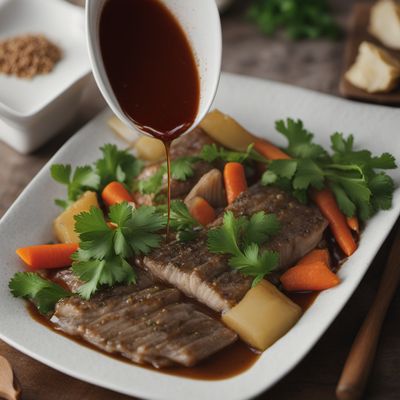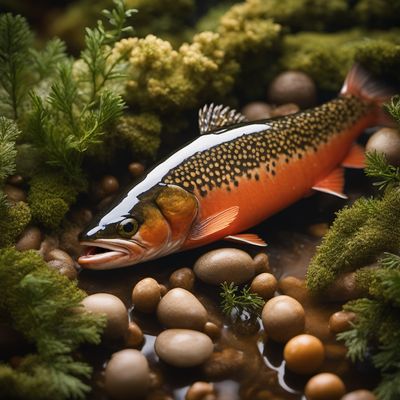
Ingredient
Arctic char
The Arctic Delicacy
Arctic char is a species of fish that belongs to the salmon family. It has a firm, pink flesh with a mild and slightly sweet flavor. The texture is tender and flaky, making it a popular choice for grilling, baking, or pan-searing. Its appearance is similar to salmon, with a silver skin and dark, speckled spots.
Origins and history
Arctic char is native to the Arctic and subarctic regions of North America, Europe, and Asia. It has been an important food source for indigenous communities in these areas for centuries. In recent years, it has gained popularity in the culinary world for its unique flavor and sustainable farming practices. Inuit and Sami cultures have a long history of fishing and consuming Arctic char, considering it a vital part of their traditional diets.
Nutritional information
Arctic char is a nutrient-dense fish that is low in calories and high in protein. It is also a good source of omega-3 fatty acids, which are beneficial for heart health and brain function. A 3-ounce serving of cooked Arctic char provides approximately 140 calories, 22 grams of protein, and 5 grams of fat.
Allergens
Arctic char may contain allergens such as fish proteins, which can trigger allergic reactions in individuals with fish allergies. It is important to exercise caution and consult with a healthcare professional if you have known fish allergies before consuming Arctic char.
How to select
When selecting Arctic char, look for fish with firm, shiny skin and a fresh, mild aroma. The flesh should be pink and moist, without any discoloration or strong fishy smell. If purchasing fillets, they should be free from any bruising or browning. Additionally, choose fish that has been sustainably sourced or farmed to support responsible fishing practices.
Storage recommendations
To maintain the freshness of Arctic char, store it in the coldest part of your refrigerator, ideally at a temperature between 32-38°F (0-3°C). Keep the fish wrapped in moisture-proof paper or plastic wrap to prevent it from drying out. Consume it within 1-2 days of purchase for the best quality and flavor.
How to produce
Arctic char can be produced through aquaculture or fish farming. It requires cold, clean water with a temperature range of 40-60°F (4-15°C). The fish can be raised in tanks or net pens, mimicking their natural habitat. It is important to provide proper filtration and aeration systems to maintain water quality and ensure the well-being of the fish.
Preparation tips
Arctic char can be prepared in various ways, including grilling, baking, broiling, or pan-searing. It pairs well with citrus flavors, dill, and other fresh herbs. For grilling, season the fish with salt, pepper, and olive oil, then cook it over medium-high heat for about 4-5 minutes per side. When baking, preheat the oven to 400°F (200°C), season the fish, and place it on a baking sheet lined with parchment paper. Bake for approximately 12-15 minutes or until the fish flakes easily with a fork. Experiment with different seasonings and cooking methods to discover your favorite preparation.
Substitutions
Salmon can be used as a substitute for Arctic char, as they share similar flavor profiles and textures. Rainbow trout or lake trout can also be used as alternatives. However, keep in mind that each fish has its own distinct characteristics, so the flavor may vary slightly.
Culinary uses
Arctic char is a versatile ingredient that can be used in a variety of culinary applications. It can be enjoyed simply grilled or baked with a squeeze of lemon juice and fresh herbs. The fish's mild flavor makes it a great canvas for various marinades, sauces, or glazes. It can also be used in salads, pasta dishes, or as a topping for sushi or sashimi.
Availability
Arctic char is commonly available in regions such as Canada, Alaska, Scandinavia, and Russia. It is also cultivated in fish farms in these areas to meet the demand for this sought-after fish.
More ingredients from this category
Recipes using Arctic char

Uht Sukusuk with Arctic Char and Wild Berries
Arctic Delight: Grilled Arctic Char with Tangy Wild Berry Sauce

Chukchi Delight: Arctic Jumps Over the Ice
Arctic Delicacy: A Chukchi Twist on a Chinese Classic

Inuit-style Arctic Salad
Arctic Delight: A Refreshing Inuit Salad

Inuit-Inspired Arctic Roast Beef Sandwich
Arctic Delight: Inuit-Inspired Roast Beef Sandwich

Inuit-inspired Arctic Rice Balls
Savory Arctic Delights: Inuit-inspired Rice Balls with a Twist

Inuit-style Arctic Char Pancakes
Arctic Delight: Inuit-Inspired Char Pancakes

Sami-style Smoked Fish with Bacon
Arctic Delight: Smoky Fish Wrapped in Bacon

